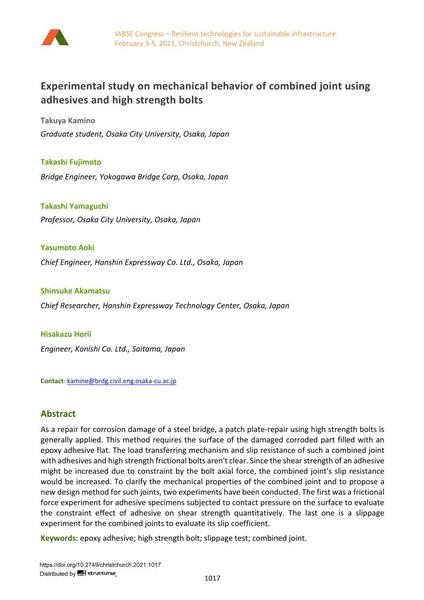Experimental study on mechanical behavior of combined joint using adhesives and high strength bolts

|
|
|||||||||||
Bibliographic Details
| Author(s): |
Takuya Kamino
(Graduate student, Osaka City University, Osaka, Japan)
Takashi Fujimoto (Bridge Engineer, Yokogawa Bridge Corp, Osaka, Japan) Takashi Yamaguchi (Professor, Osaka City University, Osaka, Japan) Yasumoto Aoki (Chief Engineer, Hanshin Expressway Co. Ltd., Osaka, Japan) Shinsuke Akamatsu (Chief Researcher, Hanshin Expressway Technology Center, Osaka, Japan) Hisakazu Horii (Engineer, Konishi Co. Ltd., Saitama, Japan) |
||||
|---|---|---|---|---|---|
| Medium: | conference paper | ||||
| Language(s): | English | ||||
| Conference: | IABSE Congress: Resilient technologies for sustainable infrastructure, Christchurch, New Zealand, 3-5 February 2021 | ||||
| Published in: | IABSE Congress Christchurch 2020 | ||||
|
|||||
| Page(s): | 1017-1023 | ||||
| Total no. of pages: | 7 | ||||
| DOI: | 10.2749/christchurch.2021.1017 | ||||
| Abstract: |
As a repair for corrosion damage of a steel bridge, a patch plate-repair using high strength bolts is generally applied. This method requires the surface of the damaged corroded part filled with an epoxy adhesive flat. The load transferring mechanism and slip resistance of such a combined joint with adhesives and high strength frictional bolts aren't clear. Since the shear strength of an adhesive might be increased due to constraint by the bolt axial force, the combined joint's slip resistance would be increased. To clarify the mechanical properties of the combined joint and to propose a new design method for such joints, two experiments have been conducted. The first was a frictional force experiment for adhesive specimens subjected to contact pressure on the surface to evaluate the constraint effect of adhesive on shear strength quantitatively. The last one is a slippage experiment for the combined joints to evaluate its slip coefficient. |
||||
| Keywords: |
epoxy adhesive high strength bolt slippage test combined joint
|
||||
